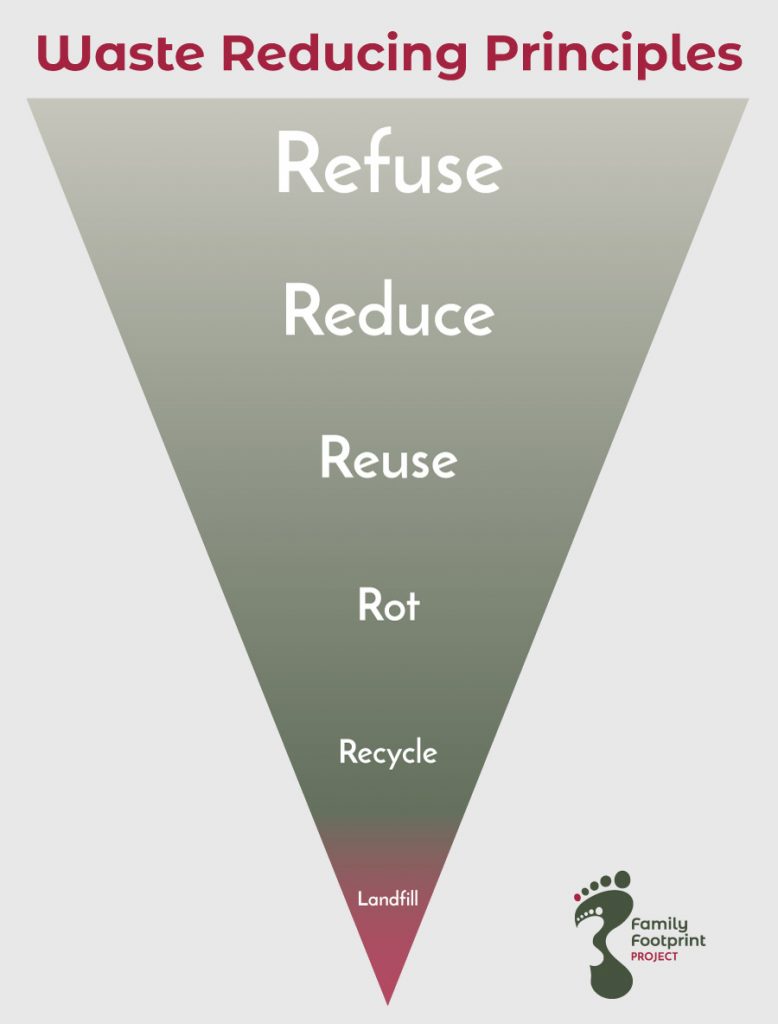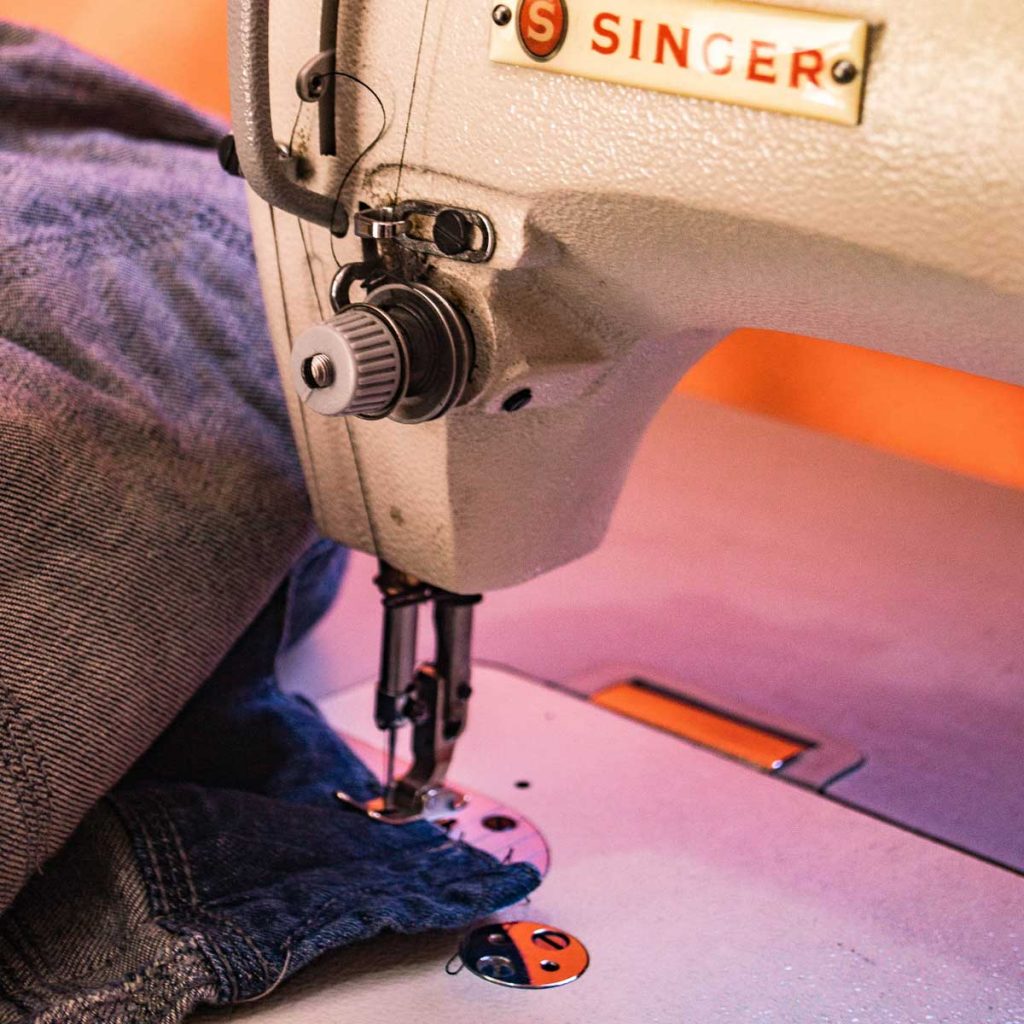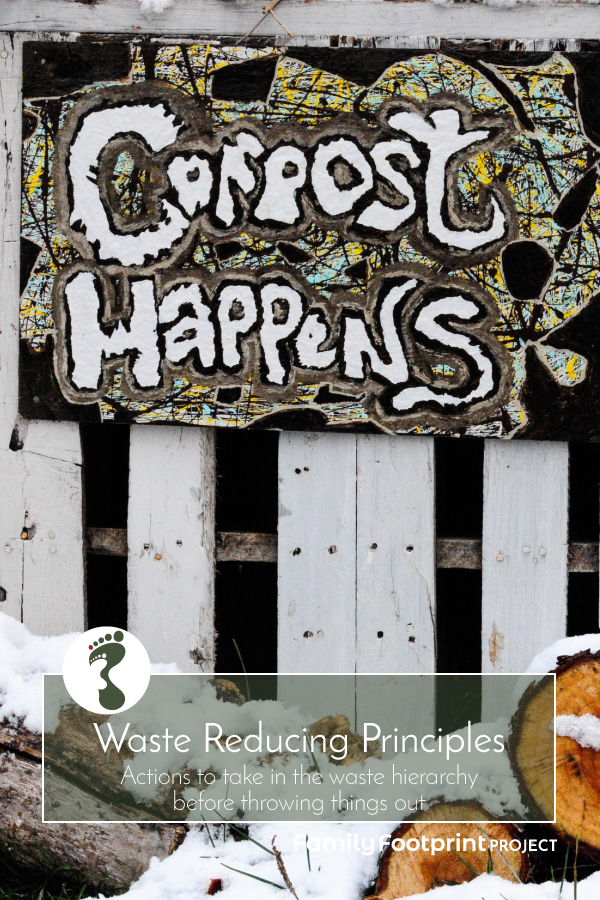What are waste reducing principles? Well, they are the actions we can take to divert our household (or office or business or factory…) waste away from landfill.
One of our family footprint goals for 2019 is to reduce as much as possible the waste in our ‘waste to landfill’ bin. My bin audit revealed that there is much we can do on this front! While recycling seems an obvious place to start, there are actually a number of steps above recycling on the waste reducing principles hierarchy. Let’s have a look at them each in turn.

Refuse
At the top of the hierarchy we have REFUSE. For me this goes beyond saying, “No straw please” or “No thank you” when offered plastic cutlery. For me this means reconsidering my consumption habits as a whole and REFUSING the cultural norms if necessary. It may have become the norm to make tea with a tea bag but I can make an easy swap to loose leaf tea. Changing one’s wardrobe every season may be commonplace but I can REFUSE to buy into the trends dictated by the fast fashion industry and wear my clothes year after year.
In these ways, and many more, I stop the waste before it even enters my life and home. And it reduces the overall demand for new products that, ultimately, are destined for landfill.
With our family footprint project, I am committed to making more conscious decisions about what we actually need to consume.
Reduce
Where it is not possible to REFUSE a waste stream altogether, I can REDUCE the amount that I need and the amount that I consume. Overall, most of us don’t need nearly as much stuff as we think we do. Perhaps we can make one item do the job of a number of items, such as a box of bicarbonate of soda and a bottle of vinegar REDUCING the number of cleaning products we need to buy. Or we can use a pared down range of products for our personal care routines.
We don’t have to live a minimalist life (unless we want to) but we can make do very well with less. Most of the time, once we’ve made the change, we won’t even notice the absence of the thing we have decided to do without.
Reuse
Whether it be buying secondhand or finding another use for an item, such as a glass jar, that we have bought for another use, REUSE is next on the hierarchy of waste reducing principles. REUSING an item ameliorates the impact its production and embodied resources have on the environment. It also reduces the demand for the creation of more of the same product.
One of my commitments for this year is to only buy new those things I really need but haven’t been been able to source secondhand. This is a commitment to REUSE.
An action that isn’t listed on the hierarchy above is REPAIR. In my mind this comes under REUSE but I have seen it stated as a separate principle. Our ‘throw away’ society is rapidly losing the skills to repair things. Indeed manufacturers are actually designing things with ‘built-in obsolescence’ or making them difficult and expensive to repair. We can say ‘no’ to this culture by demanding and choosing items that are durable and likely to have a long life, perhaps for generations to come. And we can seek out products that are more likely to be repairable then learn or hire the skills needed to do so when necessary.

Rot
ROT refers, of course, to returning organic resources to the Earth. This can be done at home with household composting and worm farms or, increasingly, there are community and local government avenues for composing.
It is obvious that this waste reducing principle applies easily to food waste but, when making other purchases such as toothbrushes, if we look for materials that can eventually rot, such as bamboo rather than plastic, it expands this principle to a wider range of consumer products.
Organic materials in landfill produce concerning levels of greenhouse gases so another goal I have for our household this year is to eliminate organic waste from our landfill bin.
Recycle
Most of us are pretty good recyclers and might be surprised to find recycling so far down the hierarchy of waste reducing principles. Recycling, however, has its problems such as contamination and a tightening of the market for recyclables leading to recyclables being sent instead to landfill. See my post on why recycling is not the answer for more on this.
Some would also say that recycling is part of a zero waste lifestyle. However, as we transition our households and communities to a low waste way of life, recycling is a better option than throwing materials that could be reclaimed into landfill.
Our family have generally been pretty good recyclers for many, many years but other than aiming to reduce the need to RECYCLE, I want to ensure that any recyclables we do need to dispose of are properly recycled. This means putting systems in place to deal with recyclables that aren’t collected by our curb-side service such as tech, batteries and soft plastics.
And we need to stop ‘wishful’ recycling that leads to contamination of recycled resources. We need to educate ourselves about precisely what can and can’t be recycled and how best to process the materials.
Landfill
At the bottom of the hierarchy comes landfill, not a waste reducing principle at all in fact. Ultimately, it would be wonderful to say we are not sending any waste to landfill. Practically speaking, however, in our current imperfect system, there will be no way to achieve this. For example, my husband takes medication daily and will for the rest of his life. It isn’t safe for him to REFUSE or REDUCE this. Clearly it can’t be REUSED. The packaging cannot ROT or be RECYCLED. Thus it will end up in landfill until it is available in, for example, a glass bottle.
While we have to accept that ‘zero waste’ might be hard, if not impossible, to achieve, we can do a very great deal to reduce the volume of waste we send to landfill. Year after year we can strive to do better and better on this front too. Our own family footprint project aims to do exactly that.
[mc4wp_form id=”96”]


